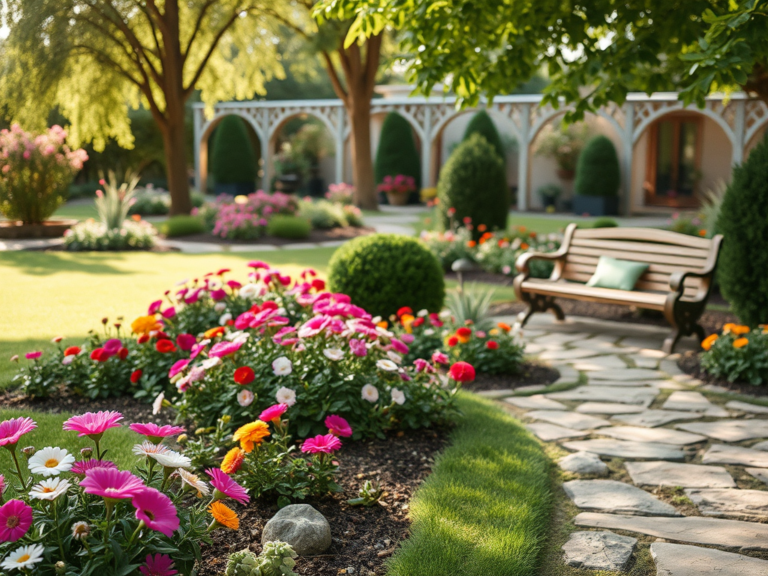Search Below For New Gardening Tips and Tricks with Practicals
Mastering the Art of Gardening: A Comprehensive Guide to Thriving Green Spaces
Table of Contents
Art of Gardening is a rewarding hobby that brings you closer to nature while beautifying your surroundings. Whether you’re cultivating flowers, vegetables, or creating a serene green space, knowing the best practices will set you up for success. In this guide, we explore crucial gardening tips, techniques, and advice to make your garden thrive.
Understanding Soil: The Foundation of a Healthy Garden
Soil is the lifeblood of your garden, and understanding its composition is key to ensuring plant growth. Begin by determining your soil type—sandy, loamy, or clay-based—so that you can select the appropriate plants and amendments.

Steps to Improve Soil Health:
- Test your soil’s pH: Most plants prefer a pH between 6.0 and 7.5. Use a soil test kit to find out the exact pH and adjust it accordingly with lime (to raise pH) or sulfur (to lower pH).
- Incorporate organic matter: Adding compost, well-rotted manure, or leaf mold improves soil structure, aids moisture retention, and boosts nutrient content.
- Mulching: Mulch around your plants to conserve moisture, regulate soil temperature, and suppress weeds. Organic mulches, like wood chips or straw, break down over time and enrich the soil.
Choosing the Right Plants for Your Climate
Selecting plants that are well-suited to your local climate ensures they will flourish with less maintenance. Understanding your USDA hardiness zone helps in picking perennials, shrubs, and trees that can withstand seasonal temperature changes.
Factors to Consider When Choosing Plants:
- Sun exposure: Evaluate the sun exposure of different areas in your garden. Some plants thrive in full sunlight, while others prefer partial or full shade.
- Water requirements: Choose drought-tolerant plants if you live in a dry region, or opt for water-loving species in areas that receive ample rainfall.
- Growing season: Plant according to the length of your growing season to ensure adequate time for plants to mature and yield flowers or produce.
Watering Techniques: How to Hydrate Your Plants Efficiently
Watering your plants appropriately is one of the most important aspects of garden care. Over-watering or under-watering can damage plant roots and hinder growth.
Effective Watering Methods:
- Drip irrigation systems: Install a drip irrigation system to provide slow, consistent moisture directly to plant roots, reducing water waste and preventing diseases from wet foliage.
- Soaker hoses: Lay soaker hoses beneath the soil or mulch to water multiple plants at once. This method ensures deep root hydration without runoff.
- Water in the morning: Morning watering helps prevent fungal growth by allowing excess water on leaves to evaporate before the evening cools.
Organic Pest Control: Protecting Your Garden Naturally
Pests are inevitable in any garden, but you can manage them effectively without resorting to harmful chemicals. Encouraging beneficial insects, using natural repellents, and keeping your garden clean can minimize damage.
Natural Pest Control Strategies:
- Companion planting: Grow certain plants together to naturally repel pests. For instance, marigolds deter aphids, and basil repels mosquitoes and flies.
- Introduce beneficial insects: Ladybugs, lacewings, and predatory wasps feed on harmful insects like aphids, caterpillars, and whiteflies.
- Use homemade insecticidal soap: Combine 1 tablespoon of dish soap with 1 quart of water and spray it on plants to eliminate soft-bodied pests.
Fertilizing for Growth: Nurturing Your Plants with the Right Nutrients
Feeding your plants ensures that they have all the essential nutrients to grow strong and produce abundant yields.
Fertilization Tips:
- Organic fertilizers: Use compost, worm castings, or fish emulsion to provide a slow-release source of nutrients. These materials enrich the soil and encourage microbial activity.
- Balanced feeding: Ensure your fertilizer contains the three main nutrients: nitrogen (N), phosphorus (P), and potassium (K). These promote leaf growth, root development, and overall plant health, respectively.
- Avoid over-fertilization: Too much fertilizer can lead to nutrient burn, where leaves turn yellow or brown. Follow the recommended guidelines on your fertilizer packaging.
Seasonal Gardening: How to Maintain Your Garden Year-Round
Successful gardening involves understanding how to care for your plants throughout the changing seasons. From planting in spring to preparing for winter, each season requires a specific approach.
Seasonal Care Overview:
- Spring: Start seeds indoors for early vegetables and flowers. Prepare garden beds by turning over the soil and adding compost.
- Summer: Maintain consistent watering, mulch around plants to retain moisture, and watch for pests. Deadhead spent flowers to encourage new blooms.
- Fall: Harvest your crops and remove any plant debris to prevent pests and diseases from overwintering. Apply a thick layer of mulch to protect plants from frost.
- Winter: In mild climates, continue planting cool-season crops like kale and spinach. In colder areas, cover delicate plants with frost blankets or bring potted plants indoors.
Conclusion
By focusing on the essentials of soil health, plant selection, proper watering, organic pest control, and seasonal maintenance, your garden will thrive year-round. With a thoughtful approach and consistent care, you’ll be rewarded with beautiful blooms, lush greenery, and a bountiful harvest.
- Comprehensive Guide to Garden Design
- The Complete Guide to Organic Gardening
- The Art and Science of Gardening: Cultivating a Thriving Garden
- The Stunning Beauty of Ranunculus: A Comprehensive Guide
- Peonies: Why Are They So Special?
Discover more from Gardening with Ecorganicas-Source for Organic Gardening Tips
Subscribe to get the latest posts sent to your email.








